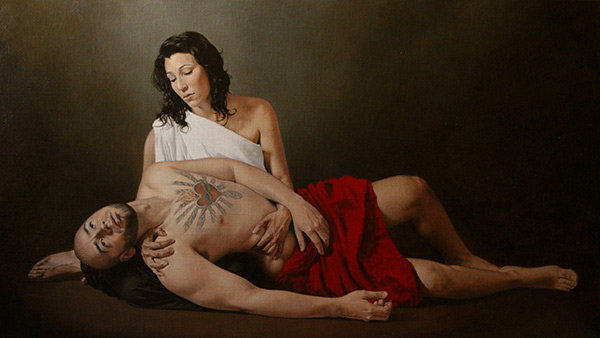Traditional art is so much more than the construction of pretty pictures. Through it, nature’s profound beauty and the human form are employed to communicate the transcendental, connecting viewers in ways that are often impossible to articulate. Artist Jason Jenkins uses painting and tradition as conduits to express universal messages, lifting viewers out of the mundane and into fulfilling experiences.
As artist Edward Hopper once remarked, “If I could say it in words, there would be no reason to paint.” Artists and connoisseurs often cite Hopper’s statement because, in its simplicity, the quote alludes to the complex ways in which representational art communicates with its viewers. Fundamentally, art is a visual language, and the traditional use of it to re-create nature’s beauty speaks to a universal spirit and connection we all share.
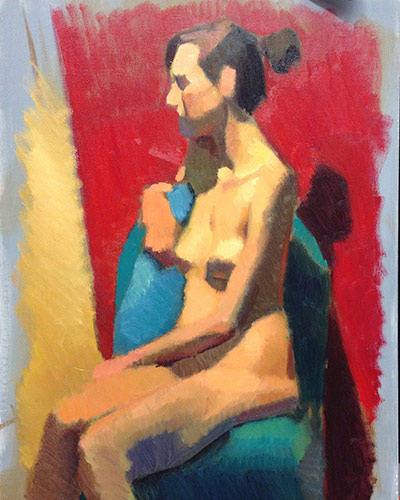
Jason Jenkins, “Color Study #120,” 2015, oil on canvas, 20 x 16 in. (c) Jason Jenkins 2016
Painter Jason Jenkins has made it his artistic mission to champion this fundamental principle, to “deliver themes, truths, and subtexts that resonate with a broad audience by traveling on a deeper current beneath the superficial elements of my images,” as he suggests. More specifically, Jenkins employs the human body in much of his art, as a potent and direct form of communication with his audiences. He writes, “That is where the glorious and beautiful potential of humanity resides; within each of us, there is divinity, and by facing each other we are witnesses to it, and hopefully accountable to it. What is more, the human figure is the one thing we all relate to, regardless of who we are or where we are from, or how much wealth or privilege we possess, or how much trauma we have suffered. It is the common language of humanity the world over. It unifies all of us, and it evokes emotion without a word in the simplest of ways: a glance or a penetrating gaze, an expression, a gesture, a state of agitation or repose. A figure can evoke feelings of anxiety or arousal, courage or hope, sympathy or despair. The figure has all the communicative power that we could possibly imagine, and it speaks to us directly, deeply, in our bones. Simultaneously it is the greatest symbol of our entrapment within the most profound polarity that there is: life and death; mortality and the urgency of being.”

Jason Jenkins, “Dione,” 2014, graphite on paper, 20 x 24 in. (c) Jason Jenkins 2016
Raised Roman Catholic, Jenkins — now a secular humanist — holds art in a place very similar to religion and believes it serves a parallel function. “In art, I see something very spiritual,” the artist says. “It speaks to a deeper, older part of us and carries within it the power of reconciliation. What I mean is, I think art has the power to help us navigate in the often ambiguous spaces of life, from establishing and maintaining a moral and ethical compass, to maintaining our emotional and spiritual health as individuals and as a community. Moreover, I think art can provide a greater capacity for compassion, courage, and consolation while uniting and keeping us in touch with our humanity. Ultimately, I see us as responsible to ourselves and each other, rather than to God’s will or judgment.”
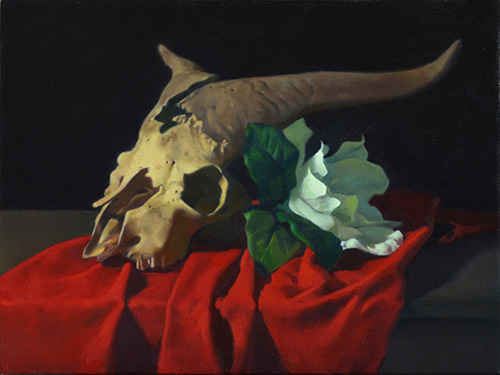
Jason Jenkins, “Evolution,” 2015, oil on canvas, 12 x 16 in. (c) Jason Jenkins 2016
His “Pietá” is a powerful illustration of these principles. The classic subject — a mourning Virgin embraces the recently deceased and deposed Christ — is here given a contemporary flavor. Without spatial context, the two subjects are positioned against a muted background. The Virgin cradles her son and gazes at his body. Noteworthy is how alive Christ appears, his open eyes and flushed skin perhaps symbolizing his moment of resurrection or offering viewers a glimpse of transcendence, or the peace that we may experience when facing our mortality. Prominently displayed across his chest is a tattoo of the Sacred Heart — a well-known Roman Catholic devotion that is meant to symbolize Christ’s divine love for humanity.
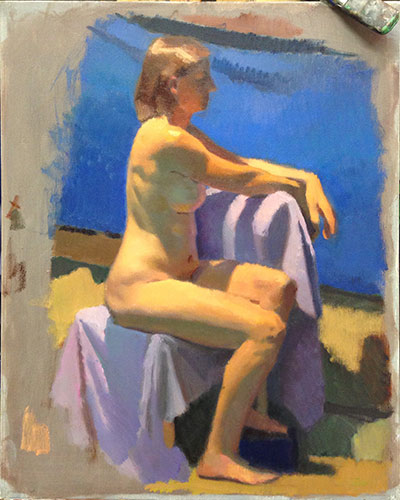
Jason Jenkins, “Full-color Figure Study,” 2015, oil on canvas, 20 x 16 in. (c) Jason Jenkins 2016
Continuing, Jenkins writes, “Perhaps one of the most relevant spaces to navigate today is the one between individuality and community, which are often confused as opposed rather than balanced. Our current cultural climate lends itself to detachment and isolation, and we are left with a holistic need that great art can fill. Great art can enable us to experience consolation, compassion, or courage, and I believe that through it, we can achieve moments of peace, clarity, or transcendence, which allows us to see the big picture, gain perspective, and reconnect with our values, ideals, and each other. It can remind us of what it is to be human and of the great importance of our principles, ethics, and unity. Art is vital to the development and maintenance of our cultural and moral fabric, and I see it as a great privilege, a responsibility, and perhaps even a sacred duty of artists to take that seriously.”
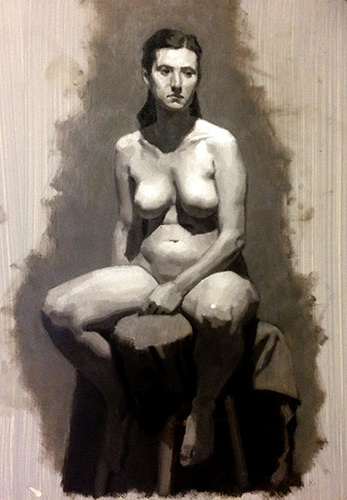
Jason Jenkins, “Value Study (Alex),” 2015, oil on panel, 20 x 16 in. (c) Jason Jenkins 2016
Currently studying at the prestigious Studio Incamminati, Jenkins seeks to continue exploring these themes in future works. An acknowledged lover of Caravaggio, Bernini, Rembrandt, Jacques-Louis David, and many other classical painters, Jenkins says he is “interested in exploring classical themes from mythology, biblical stories, history, and possibly fantasy as well, but I want to do so in a way that highlights humanist undercurrents and makes connections to contemporary viewers. I want to create work that pulls from the history and tradition of this profession, and that also perhaps pulls on dramatic compositional developments pioneered by film and comic book professionals. I aim for my work to underscore the universal truths of mortality and the experience of living, that unites us all on common ground; that employs beauty and tragedy; to elicit compassion, courage, and consolation. Ultimately, I am inspired to produce work that evokes moments of clarity and transcendence, that puts us back in touch with what it is to be human, and to remind us that we are all precious and need each other.”
To learn more, visit Jason Jenkins.
You can also find Jason’s work at:
www.facebook.com/jasonpatrickjenkinsart
www.instagram.com/jasonpatrickjenkins
[email protected]
This article was featured in Fine Art Today, a weekly e-newsletter from Fine Art Connoisseur magazine. To start receiving Fine Art Today for free, click here.

